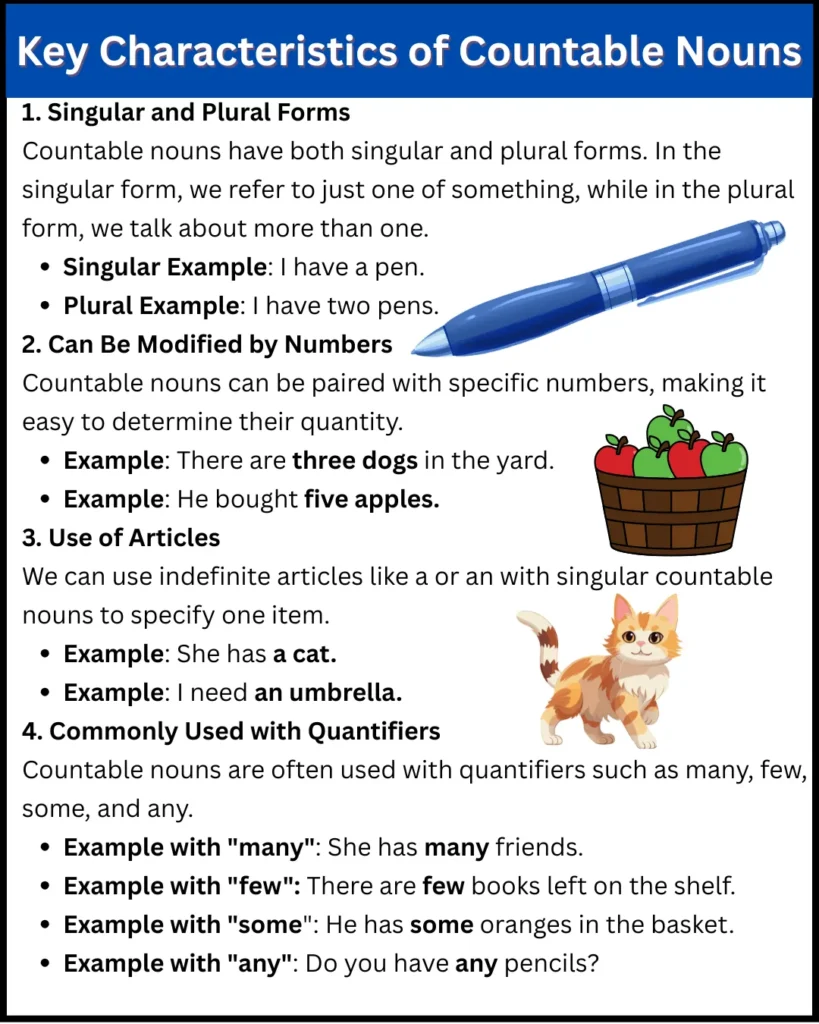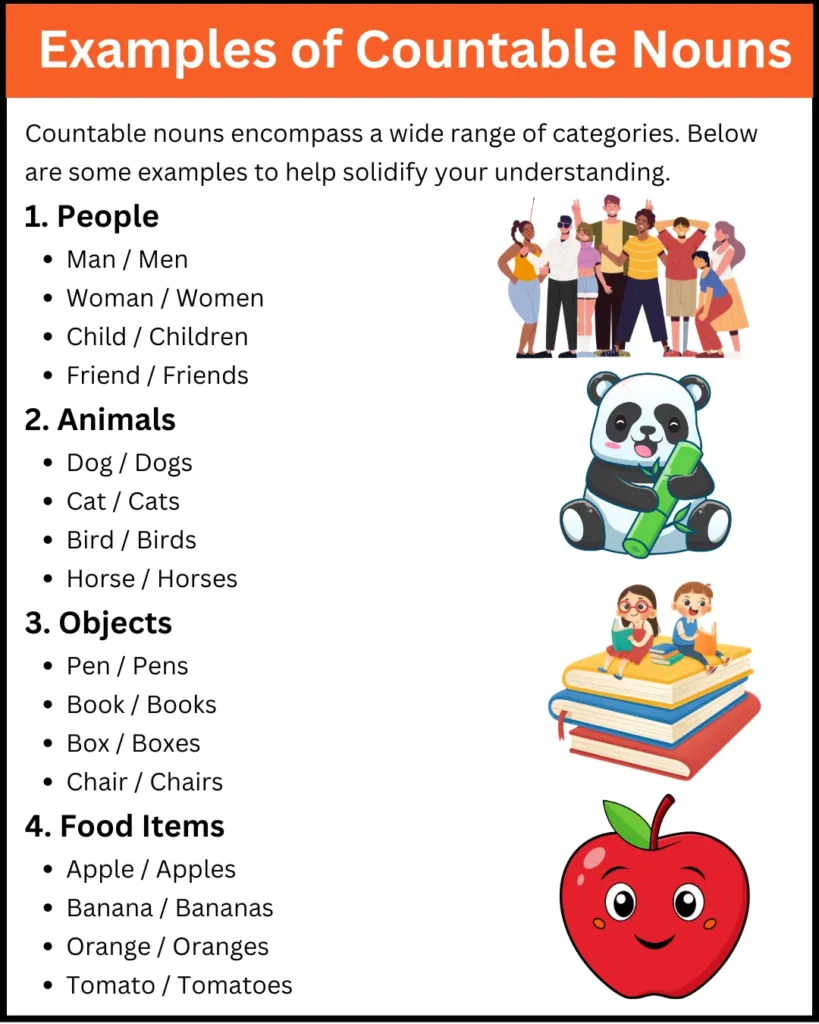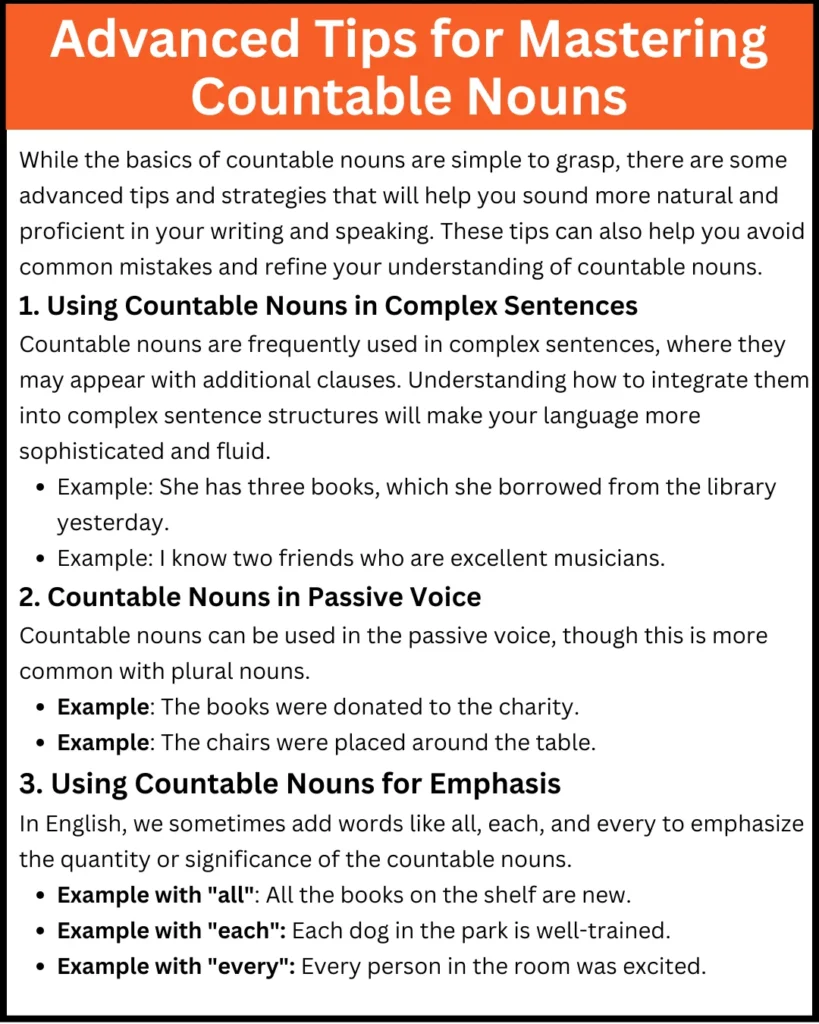Countable nouns are one of the fundamental aspects of English grammar. Understanding them is essential for both beginners and advanced learners alike. This article will explore countable nouns in depth, offering examples, important rules, and tips to help you master their use. By the end of this guide, you’ll have a complete understanding of how to identify and use countable nouns correctly in both written and spoken English.
What are Countable Nouns?
Countable nouns refer to things that we can count individually. These are objects or items that can be expressed as singular or plural, depending on the quantity being referred to. Simply put, if you can ask “How many?” and answer with a number, the noun in question is countable.
Definition of Countable Nouns
-
Countable Nouns are those that can be counted directly, either in singular or plural forms.
-
Examples include objects, animals, and people that we can quantify.
For instance:
-
“One book” (singular)
-
“Three books” (plural)

Key Characteristics of Countable Nouns
1. Singular and Plural Forms
Countable nouns have both singular and plural forms. In the singular form, we refer to just one of something, while in the plural form, we talk about more than one.
-
Singular Example: I have a pen.
-
Plural Example: I have two pens.
2. Can Be Modified by Numbers
Countable nouns can be paired with specific numbers, making it easy to determine their quantity.
-
Example: There are three dogs in the yard.
-
Example: He bought five apples.
3. Use of Articles
We can use indefinite articles like a or an with singular countable nouns to specify one item.
-
Example: She has a cat.
-
Example: I need an umbrella.
4. Commonly Used with Quantifiers
Countable nouns are often used with quantifiers such as many, few, some, and any.
-
Example with “many”: She has many friends.
-
Example with “few”: There are few books left on the shelf.
-
Example with “some”: He has some oranges in the basket.
-
Example with “any”: Do you have any pencils?
Examples of Countable Nouns
Countable nouns encompass a wide range of categories. Below are some examples to help solidify your understanding.
1. People
-
Man / Men
-
Woman / Women
-
Child / Children
-
Friend / Friends
2. Animals
-
Dog / Dogs
-
Cat / Cats
-
Bird / Birds
-
Horse / Horses
3. Objects
-
Pen / Pens
-
Book / Books
-
Box / Boxes
-
Chair / Chairs
4. Food Items
-
Apple / Apples
-
Banana / Bananas
-
Orange / Oranges
-
Tomato / Tomatoes
5. Tools and Equipment
-
Hammer / Hammers
-
Screwdriver / Screwdrivers
-
Table / Tables
-
Bag / Bags

Rules for Using Countable Nouns
Countable nouns follow specific grammar rules that make them distinct from uncountable nouns. Knowing when and how to use them correctly is essential for constructing accurate sentences in English.
1. Using Articles with Countable Nouns
In English, the indefinite articles a and an are used with singular countable nouns to indicate a single item.
-
Example with “a”: I saw a dog in the park.
-
Example with “an”: She bought an apple from the market.
Note: Use a before words that begin with a consonant sound, and an before words that start with a vowel sound.
-
Example with “a”: a pen, a dog
-
Example with “an”: an orange, an umbrella
2. Plural Form of Countable Nouns
To make countable nouns plural, simply add -s or -es. The general rule is to add -s, but for nouns ending in certain letters (like s, x, z, sh, and ch), we add -es to form the plural.
-
General Rule: pen → pens, dog → dogs
-
With “-es”: box → boxes, church → churches
3. Using Quantifiers with Countable Nouns
Countable nouns work with specific quantifiers, which help describe their quantity. Below are the most common ones:
-
Few: Refers to a small number of countable nouns.
-
Example: There are few books on the shelf.
-
-
Many: Refers to a large number of countable nouns.
-
Example: She has many friends.
-
-
A few: Refers to a small but countable number.
-
Example: We have a few tickets left.
-
-
Several: Refers to more than two but not a large number.
-
Example: I have several pencils.
-
-
Some: Used to express an indefinite quantity of countable nouns, often in positive statements.
-
Example: I have some coins.
-
-
Any: Used in questions and negative statements.
-
Example: Do you have any pens?
-
Example: We don’t have any chairs.
-
4. Using Countable Nouns with “This” and “These”
When talking about countable nouns in the singular, we often use the demonstrative pronoun this. For the plural form, we use these.
-
Singular: This dog is very playful.
-
Plural: These dogs are very playful.
5. Countable Nouns in Negative Sentences
In negative sentences, countable nouns are used with any, as shown below:
-
Example: I don’t have any pencils.
-
Example: There aren’t any apples left.
Common Mistakes with Countable Nouns
While countable nouns are easy to identify, learners often make certain mistakes when using them. Here are some common errors and tips on how to avoid them:
1. Confusing Countable and Uncountable Nouns
One of the most frequent mistakes is confusing countable nouns with uncountable nouns. Remember, countable nouns can be counted individually, while uncountable nouns refer to things that cannot be counted, such as liquids, gases, or abstract concepts.
Mistake:
-
Incorrect: I have much books.
-
Correct: I have many books.
Mistake:
-
Incorrect: There is some chairs in the room.
-
Correct: There are some chairs in the room.
2. Omitting Articles
Another mistake is omitting articles when they are required. In English, we generally need an article before singular countable nouns, unless the noun is plural or uncountable.
Mistake:
-
Incorrect: She has dog.
-
Correct: She has a dog.
Mistake:
-
Incorrect: Apples are on the table.
-
Correct: The apples are on the table.
3. Using Incorrect Quantifiers
Sometimes learners use the wrong quantifiers with countable nouns. For example, much is used with uncountable nouns, while many should be used with countable nouns.
Mistake:
-
Incorrect: How much chairs are there?
-
Correct: How many chairs are there?
Mistake:
-
Incorrect: I have many money.
-
Correct: I have much money. (Note: “Money” is uncountable.)
4. Misusing Plural Forms
Some learners forget to make nouns plural when necessary or add an extra -s when not required.
Mistake:
-
Incorrect: I have two cat.
-
Correct: I have two cats.
Mistake:
-
Incorrect: There are five childs in the group.
-
Correct: There are five children in the group.
5. Incorrect Word Order
Occasionally, the word order might get mixed up, especially when countable nouns are used with quantifiers or in plural form.
Mistake:
-
Incorrect: I have few friends.
-
Correct: I have a few friends.
Mistake:
-
Incorrect: She gave many gifts to me.
-
Correct: She gave me many gifts.

Advanced Tips for Mastering Countable Nouns
While the basics of countable nouns are simple to grasp, there are some advanced tips and strategies that will help you sound more natural and proficient in your writing and speaking. These tips can also help you avoid common mistakes and refine your understanding of countable nouns.
1. Using Countable Nouns in Complex Sentences
Countable nouns are frequently used in complex sentences, where they may appear with additional clauses. Understanding how to integrate them into complex sentence structures will make your language more sophisticated and fluid.
-
Example: She has three books, which she borrowed from the library yesterday.
-
Example: I know two friends who are excellent musicians.
2. Countable Nouns in Passive Voice
Countable nouns can be used in the passive voice, though this is more common with plural nouns.
-
Example: The books were donated to the charity.
-
Example: The chairs were placed around the table.
3. Using Countable Nouns for Emphasis
In English, we sometimes add words like all, each, and every to emphasize the quantity or significance of the countable nouns.
-
Example with “all”: All the books on the shelf are new.
-
Example with “each”: Each dog in the park is well-trained.
-
Example with “every”: Every person in the room was excited.
4. Countable Nouns with Expressions of Quantity
Countable nouns can often be combined with specific expressions of quantity that help provide more clarity in a sentence.
-
Expression with “a number of”: There are a number of books on the table.
-
Expression with “a couple of”: She bought a couple of apples from the store.
-
Expression with “several”: There are several chairs in the room.
5. Common Idiomatic Expressions with Countable Nouns
Countable nouns are often part of idiomatic expressions or fixed phrases. Mastering these can help you understand native-level English more easily and communicate with greater fluency.
-
Example with “a great many”: There are a great many people waiting for the bus.
-
Example with “a lot of”: He has a lot of friends in the city.
-
Example with “plenty of”: She has plenty of coins in her wallet.
6. Plural Forms of Irregular Countable Nouns
Certain countable nouns have irregular plural forms that don’t follow the standard rule of adding -s or -es. It’s important to recognize these exceptions.
-
Man → Men
-
Woman → Women
-
Child → Children
-
Foot → Feet
-
Tooth → Teeth
